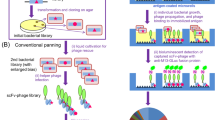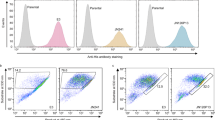Abstract
Phage display techniques rely on nearly random oligonucleotide sequences inserted into the protein III filament binding protein of an Escherichia coli filamentous phage M13 to generate a library of phage that express more than 10 7 different peptides. Phage that expresses a sequence having high affinity for a specific molecule, cell, or tissue can then be isolated through selective binding and recovery. Selected phage cannot only be used as gene transfer vectors in themselves, but the small peptide epitopes can be sequenced and potentially recombined into the attachment proteins of viral vectors, or used by themselves to target other therapeutic agents and diagnostic imaging radiolabels. Most phage display selections are carried out against purified and/or fixed protein targets, raising concerns as to the relevance of the selected epitopes. We have selected phage from the CMTI library against viable U87-MG human malignant glioma cells using a derivation of biopanning. The library, which initially contained phage expressing 2×10 7 different epitope sequences, collapsed after four rounds of selection such that 42% of recovered clones expressed a consensus sequence. Selective binding to viable adherent U87-MG cells was subsequently demonstrated under physiologic conditions at 167% (±27%) unselected phage using a novel, viable enzyme-linked immunosorbent assay technique. In comparison, there was no difference in binding to control 9L rat gliosarcoma, PANC-1 human pancreatic adenocarcinoma, T98-MG human malignant glioma, or AST-4 human malignant glioma cells of selected compared to unselected phage. Using polymerase chain reaction, the epitope was recovered with flanking unique restriction sites for recombination into a herpes simplex virus type-1 vector. This study demonstrates and discusses optimized methodologies for using phage display to target viable cells. Cancer Gene Therapy (2001) 8, 506–511
This is a preview of subscription content, access via your institution
Access options
Subscribe to this journal
Receive 12 print issues and online access
$259.00 per year
only $21.58 per issue
Buy this article
- Purchase on Springer Link
- Instant access to full article PDF
Prices may be subject to local taxes which are calculated during checkout
Similar content being viewed by others
References
Czuczman MS, Grillo-Lopez AJ, White CA, et al . Treatment of patients with low-grade B-cell lymphoma with the combination of chimeric anti-CD20 monoclonal antibody and CHOP chemotherapy J Clin Oncol 1999 17: 268–276
Witzig T, Wiseman G, White CA, et al . IDEC-Y2B8 90yttrium anti-CD20 radioimmunotherapy of relapsed non-Hodgkin's lymphoma (NHL): interim results of a phase I/II trial Blood 1997 90: 586A
Liu H, Moy P, Kim S, et al . Monoclonal antibodies to the extracellular domain of prostate-specific membrane antigen also react with tumor vascular endothelium Cancer Res 1997 57: 3629–3634
de Jong M, Breeman WA, Bernard HF, et al . Comparison of In-111–labeled somatostatin analogs J Nucl Med 1999 40: 79P
Spear MA . Gene therapy of gliomas: receptor and transcriptional targeting Anticancer Res 1998 18: 3223–3231
Wickham TJ . Targeting Adenovirus Gene Ther 2000 7: 110–114
Parmley S, Smith G . Antibody-selectable filamentous fd phage vectors: affinity purification of target genes Gene 1989 73: 305–318
Ladner R, Guterman S . PCT patent application W090/02809 Patent 1990
O'Neil K, Hoess R . Phage display: protein engineering by directed evolution Curr Opin Struct Biol 1995 5: 443–449
Pasqualini R, Ruoslahti E . Organ targeting in vivo using phage display peptide libraries Nature. 1996 380: 364–366
Arap W, Pasqualini R, Ruoslahti E . Cancer treatment by targeted drug delivery to tumor vasculature in a mouse model Science (Washington, DC) 1998 279: 377–380
Larocca D, Kassner PD, Witte A, Ladner RC, Pierce GF, Baird A . Gene transfer to mammalian cells using genetically targeted filamentous bacteriophage FASEB J 1999 13: 727–734
Kassner PD, Burg MA, Baird A, Larocca D . Genetic selection of phage engineered for receptor-mediated gene transfer to mammalian cells Biochem Biophys Res Commun 1999 264: 921–928
Spear MA . Efficient DNA subcloning through selective restriction endonuclease digestion BioTechniques 2000 28: 660–668
Ridgeway JBB, Ng E, Kern JA, et al . Identification of a human anti-CD55 single chain Fv by subtractive panning of a phage library using tumor and nontumor cell lines Cancer Res 1999 59: 2718–2723
Boviatsis EJ, Park JS, Sena-Esteves M, et al . Long-term survival of rats harboring brain neoplasms treated with ganciclovir and a herpes simplex virus vector that retains an intact thymidine kinase gene Cancer Res 1994 54: 5745–5751
Chase M, Chung RY, Chiocca EA . An oncolytic viral mutant that delivers the CYP2B1 transgene and augments cyclophosphamide chemotherapy Nat Biotechnol 1998 16: 444–448
Lu J, Sloan SR . An alternating selection strategy for cloning phage display antibodies J Immunol Methods 1999 228: 109–119
Katakura Y, Lim ET, Tsujii S, Omasa T, Suga K-I . The importance of ionic strength as parameter in screening peptide ligands from a phage display library J Ferment Bioeng 1998 85: 447–450
Acknowledgements
This work was supported, in part, by Dyax, NCI Grant CA 69146, the UCSD Cancer Center, and UCSD Department of Radiology.
Author information
Authors and Affiliations
Corresponding author
Additional information
Portions of this abstract were presented at the 8th Gene Therapy of Cancer Conference, San Diego, CA, December 9–11, 1999 and the 91st American Association for Cancer Research Meeting, San Francisco, CA, April 1–5, 2000.
Rights and permissions
About this article
Cite this article
Spear, M., Breakefield, X., Beltzer, J. et al. Isolation, characterization, and recovery of small peptide phage display epitopes selected against viable malignant glioma cells. Cancer Gene Ther 8, 506–511 (2001). https://doi.org/10.1038/sj.cgt.7700334
Received:
Published:
Issue Date:
DOI: https://doi.org/10.1038/sj.cgt.7700334
Keywords
This article is cited by
-
Development of peptides targeting receptor binding site of the envelope glycoprotein to contain the West Nile virus infection
Scientific Reports (2021)
-
Targeting human glioma cells using HSV-1 amplicon peptide display vector
Gene Therapy (2010)
-
Tumor cell-targeting by phage-displayed peptides
Cancer Gene Therapy (2002)



